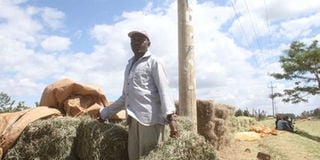Hey, rice straws add no value to dairy cows

Benson Wanjohi waits for customers for his bales of rice straw along Embu- Makutano Highway in Kirinyaga County. PHOTO | JOSEPH KANYI | NATION MEDIA GROUP
What you need to know:
- Poor quality feeds affect animal functions in their bodies.
- Farmers are using the rice straws because they are readily available and are cheap. But they just fill the rumen.
- The straws are a good alternative in rations for cattle but they must be supplemented with high quality feeds.
- Consumption of straws can be increased by grinding and mixing with higher quality feeds like hay or silage.
Huge bales of rice straws placed along the Mwea-Makutano highway in Kirinyaga County stand out as one drives on the road.
The tens of bales signal one thing, that there is increased demand for the straws which livestock farmers have turned to as the cost of animal feeds rises and pasture becomes hard to come by especially during the dry season.
Benson Wanjohi, a rice farmer at the Mwea Irrigation Scheme, is among those reaping from the growing demand of rice straws.
Initially, he used to burn the straws after harvesting rice.
“Once we harvest the rice, we dry them and bale for cattle farmers,” he says.
The practice, according to Wanjohi, began when livestock herders from arid areas flocked Kirinyaga years back seeking the straws to save their animals from drought.
“The herders came from Isiolo, Garissa, Marsabit and Moyale sometime in 2012, and pleaded with us to let them pick the straws. We did not have any other use for them, so we allowed them to take but when they returned, we started to sell,” he recounts.
Wanjohi has four Friesian animals, a bull and three dairy cows, and he says he feeds them on the rice straws as a supplement for napier grass mixed with molasses and dairy meal.
His cows produce 15 to 20 litres each a day, with the farmer letting them graze on the straws after they dry.
“To produce quality straws for animal feeds, harvest the rice then let the plants dry for about a week. Those who want to sell harvest then bale but for me I let my animals graze in the field,” he explains.
The rice straws are sold at Sh15,000 per acre, with the portion producing between 300 and 400 bales. Each bale is sold at between Sh180 and Sh200.
SUBSTANDARD FEEDS
On a good day, especially when demand is high during dry seasons, farmers make up to Sh80,000.
Robert Thuo, an agriculturalist in Nyeri, notes that rice straws should not be used as the main feed but as filler materials as they do not have any benefits to the animal.

Workers feed rice straw into a baler to make livestock feed along Embu- Makutano Highway in Kirinyaga County. PHOTO | JOSEPH KANYI | NATION MEDIA GROUP
“Farmers are using the rice straws because they are readily available and are cheap. But they just fill the rumen,” he says.
According to him, the straws are only rich in lignin, cellulose and hemicellulose but poor in minerals and vitamins.
However, they can serve as supplement if mixed with fish meal, soymeal, cotton cake and sunflower, which will supply the animal with proteins.
He says for pastoralists, rice straws may be of value as the farmer needs to see their animals through the dry period.
“What rice straws do to the animal is to help it perform its daily functions such as stand, walk and urinate but it does not help in increasing milk production,” he adds.
He cautions dairy farmers against feeding animals with substandard feeds that also include wheat and barley straws as they seek to lower cost of production, adding that the straws should not be relied on as a substantive animal feed since they are poor in quality.
He adds that once the animals are accustomed to poor quality feeds some functions in their bodies are greatly interfered with, including heat detection.
Besides rice, we have barley, flax, millet, oat, rye, soya bean and wheat straws.
The straws are a good alternative in rations for cattle but they must be supplemented with high quality feeds.
Straws do not provide enough nutrients to animals.
Consumption of straws can be increased by grinding and mixing with higher quality feeds like hay or silage.





